Recycled Concrete Aggregates and Their Influences on Performances of Low and Normal Strength Concretes
Abstract
1. Introduction
Research Significance and Contribution
2. Experimental Work
2.1. Materials Used
2.2. Concrete Proportioning
2.3. Concrete Sampling
2.4. Testing Procedures
3. Results and Discussion
3.1. Workability
3.2. Mechanical Performances
3.2.1. Compressive Strength Development
3.2.2. Modulus of Elasticity
3.2.3. Flexural strength
3.2.4. Splitting Tensile Strength
3.3. Durability Performances
3.3.1. Porosity
3.3.2. Carbonation Resistance
3.3.3. Sulphate Resistance
3.3.4. Chloride Permeation
4. Summary and Conclusive Remarks
- It was found that RCA derived from waste debris of construction demolition can be used as a secondary aggregate in concrete. Overall, their physical and mechanical characteristics are acceptable and within the requirements limits of BS-related Standard test methods. The RCA characterization indicates a lower density and unit weight, as well as a higher crushing value and water absorption with respect to the natural aggregate.
- A series of low and normal strength concretes were designed using RCA as a partial and full substitution of the natural coarse aggregate. By adjusting the w/c ratio, the target design strength was achieved for all concretes including mixes with a full substitution of NCA by the RCA.
- Although a slight increase in the initial slump values of the RCA-concrete was observed, the overall usage of RCA did not significantly affect the workability of RCA-concrete.
- At the hardened state and overall, the incorporation of RCA into concrete has reduced the compressive, flexural and tensile splitting strengths, and the elastic modulus of the RCA-concrete. This reduction was proportional to the RCA content in the concrete.
- Although the RCA have lower quality with respect to the natural aggregates, the durability performances of concrete made with the RCA were not significantly deteriorated. A slight increase in the porosity of RCA-concrete was noticed, which led to an increase in the carbonation depth and the swelling generated by the sulphate attack. Total chloride ingress has also increased, especially for the concrete made with 100% RCA.
- It is concluded that using up to 30% of the RCA indicated no significant negative impact on the key mechanical and durability properties of the RCA-concretes, even some strength enhancement was observed up to 50% replacement ratio, especially for C25/30 concrete grade. However, durability performances including carbonation, sulphate, and chloride attack resistances decreased when increasing the RCA content beyond 30% replacement level.
- Finally, although RCA are for the most common practices used in low to normal strength concrete, RCA could also be employed to produce concrete having higher strength (30 MPa and more) and acceptable durability.
Author Contributions
Funding
Conflicts of Interest
References
- Vivian, W.Y.; Tam, M.S.; Evangelista, A.C.J. A review of recycled aggregate in concrete applications (2000–2017). Constr. Build. Mater. 2018, 172, 272–292. [Google Scholar]
- Meddah, M.S. Recycled aggregates in concrete production: Engineering properties and environmental impact. MATEC Web Conf. 2017, 101, 5021. [Google Scholar] [CrossRef]
- Silva, R.V.; de Brito, J.; Dhir, R.K. Fresh-state performance of recycled aggregate concrete: A review. Constr. Build. Mater. 2018, 178, 19–31. [Google Scholar] [CrossRef]
- Hasaba, S.; Kawamura, M.; Toorii, K.; Takemoto, K. Drying shrinkage and durability of concrete made with recycled concrete aggregates. Trans. Jpn. Concr. Inst. 1981, 3, 55–60. [Google Scholar]
- Hansen, T.C.; Narud, H. Strength of recycled concrete made from crushed concrete coarse aggregate. Concr. Int. Des. Constr. 1983, 5, 79–83. [Google Scholar]
- Nixon, P.J. Recycled concrete as an aggregate for concrete—A review. Mater. Struct. RILEM 1977, 65, 371–378. [Google Scholar] [CrossRef]
- Huisman, C.L.; Briston, R.A. Recycled Portland cement concrete specifications and control, FHWA; Federal Highway Report FHWA-TS-82-208. In Proceedings of the National Seminar on PCC Pavement recycling and rehabilitation, St. Louis, MO, USA, 28–30 September 1982. [Google Scholar]
- Building Contractors Society of Japan. Study on recycled aggregate and recycled aggregate concrete, BCSJ, Committee on Disposal and Reuse of Concrete Construction Waste. Concr. J. 1978, 16, 18–31. [Google Scholar] [CrossRef]
- Ravindrarajah, R.S.; Tam, C.T. Properties of concrete made with crushed concrete as coarse aggregate. Mag. Concr. Res. 1985, 37, 29–38. [Google Scholar] [CrossRef]
- Mukai, T.; Kemi, T.; Nakagawa, M.; Kikuchi, M. Study on reuse of waste concrete for aggregate of concrete. In Proceedings of the Seminar on Energy and Resource Conservation in Concrete Technology, Japan-US Cooperative Science Programme, San Fransisco, CA, USA, 10–13 September 1979. [Google Scholar]
- Malhotra, V.M. Use of recycled concrete as a new aggregate. Report, No.76-8. In Proceedings of the Symposium on Energy and Resource Conservation in the Cement and Concrete Industry, CANMET, Ottawa, ON, Canada, 21–23 October 1978. [Google Scholar]
- Buck, A.D. Recycled concrete as a source of aggregate. ACI J. 1977, 74, 212–219. [Google Scholar]
- Abdelfattah, A.; Tabsh, S.W. Feasibility of using recycled concrete in the United Arab Emirates. In Proceedings of the ICPCM—A New Era of Building, Cairo, Egypt, 18–20 February 2003. [Google Scholar]
- Tang, W.; Khavarian, M.; Yousefi, A.; Cui, H. Properties of Self-Compacting Concrete with Recycled Concrete Aggregates. In Self-Compacting Concrete: Materials, Properties and Applications; Siddique, R., Ed.; Woodhead Publishing: Cambridge, UK, 2020; pp. 219–248. [Google Scholar]
- Ryu, J.S. An experimental study on the effect of recycled aggregate on concrete properties. Mag. Concr. Res. 2002, 54, 7–12. [Google Scholar] [CrossRef]
- Tang, W.; Khavarian, M.; Yousefi, A.; Chan, R.W.K.; Cui, H. Influence of Surface Treatment of Recycled Aggregates on Mechanical Properties and Bond Strength of Self-Compacting Concrete. Sustainability 2019, 11, 4182. [Google Scholar] [CrossRef]
- Pacheco, J.; de Brito, J.; Chastre, C.; Evangelista, L. Experimental investigation on the variability of the main mechanical properties of concrete produced with coarse recycled concrete aggregates. Constr. Build. Mater. 2019, 201, 110–120. [Google Scholar] [CrossRef]
- Chen, H.J.; Yen, T.; Chen, K.H. Use of building rubbles as recycled aggregates. Cem. Concr. Res. 2003, 33, 125–132. [Google Scholar] [CrossRef]
- Katz, A. Properties of concrete made with recycled aggregate from partially hydrated old concrete. Cem. Concr. Res. 2003, 33, 703–711. [Google Scholar] [CrossRef]
- Al-Harthy, A.S.; Taha, R.; Al-Saidy, A.; Al-Oraimi, S. Properties of recycled aggregate concrete. In Proceedings of the 2nd ACI-Kuwait Chapter Conference, Kuwait City, Kuwait, 12–15 March 2007. [Google Scholar]
- Mostafa, T.; Parviz, S. Strength of recycled aggregate concrete made using filed-demolished concrete as aggregate. ACI Mater. J. 1996, 93, 182–190. [Google Scholar]
- Buyle-Bodin, F.; Hadjieva-Zaharieva, R. Influence of industrially produced recycled aggregates on flow properties of concrete. Mater. Struct. 2002, 35, 504–509. [Google Scholar] [CrossRef]
- Leemann, A.; Loser, R. Carbonation resistance of recycled aggregate concrete. Constr. Build. Mater. 2019, 204, 335–341. [Google Scholar] [CrossRef]
- Zaharieva, R.; Buyle-Bodin, F.; Skoczylas, F.; Wirquin, E. Assessment of the surface permeation properties of recycled aggregate concrete. Cem. Concr. Compos. 2003, 25, 223–232. [Google Scholar] [CrossRef]
- Neves, R.; Silva, A.; De Brito, J.; Silva, R.V. Statistical modelling of the resistance to chloride penetration in concrete with recycled aggregates. Constr. Build. Mater. 2018, 182, 550–560. [Google Scholar] [CrossRef]
- European Aggregates Association/Union Européenne des Producteurs de Granulats (UEPG). Available online: http://www.uepg.eu/ (accessed on 25 August 2020).
- European Committee for Standardization (CEN). Concrete—Part 1: Specification, Performance, Production and Conformity; EN 206-1: 2000; CEN: Brussels, Belgium, 2000. [Google Scholar]
- British Standards Institution (BSI). Cement. Composition, Specification and Conformity Criteria for Common Cements; BS EN 197-1: 2011; BSI: London, UK, 2011. [Google Scholar]
- ASTM International. ASTM C150/C150M Standard Specification for Portland Cement; ASTM International: West Conshohocken, PA, USA, 2020; Available online: www.astm.org (accessed on 25 June 2020).
- British Standards Institution (BSI). Concrete—Complementary British Standard to BS EN 206 Part 2: Specification for Constituents Materials and Concrete (+A1:2012); BS 8500-2: 2015; BSI: London, UK, 2015. [Google Scholar]
- British Standards Institution (BSI). Tests for Geometrical Properties of Aggregates. Part 1: Determination of Particle Size Distribution; BS EN 933-12012; BSI: London, UK, 2012. [Google Scholar]
- British Standards Institution (BSI). Specification for Aggregates from Natural Sources for Concrete; BS 882:1992; BSI: London, UK, 1992. [Google Scholar]
- British Standards Institution (BSI). Aggregates for Concrete; BS EN 12620:2002+A1; BSI: London, UK, 2002. [Google Scholar]
- British Standards Institution (BSI). Testing Concrete—Part 102: Method for Determination of Slump; BS 1881-102:1983; BSI: London, UK, 1983. [Google Scholar]
- British Standards Institution (BSI). Testing Concrete—Part 103: Method for Determination of Compacting Factor; BS 1881-103:1993; BSI: London, UK, 1993. [Google Scholar]
- British Standards Institution (BSI). Testing Concrete—Part 125: Methods for Mixing and Sampling Fresh Concrete in the Laboratory; BS 1881-125: 1986; BSI: London, UK, 1986. [Google Scholar]
- British Standards Institution (BSI). Testing Concrete—Part 108: Method for Making Test Cubes from Fresh Concrete; BS 1881-108: 1983; BSI: London, UK, 1983. [Google Scholar]
- British Standards Institution (BSI). Testing Hardened Concrete. Compressive Strength of Test Specimens; BS EN 12390-3:2002; BSI: London, UK, 2002. [Google Scholar]
- British Standards Institution (BSI). Testing Concrete—Part 103: Method for Determination of Tensile Splitting Strength; BS 1881-117: 1983; BSI: London, UK, 1983. [Google Scholar]
- British Standards Institution (BSI). Testing Concrete—Part 103: Method for Determination of Flexural Strength; BS 1881-118: 1983; BSI: London, UK, 1983. [Google Scholar]
- British Standards Institution (BSI). Testing Concrete. Method for Determination of Static Modulus of Elasticity in Compression; BS 1881-121:1983; BSI: London, UK, 1983. [Google Scholar]
- British Standards Institution (BSI). Testing Concrete. Recommendations for the Determination of the Initial Surface Absorption of Concrete; BS 1881-208:1996; BSI: London, UK, 1996. [Google Scholar]
- British Standards Institution (BSI). Specification for Sulfate-Resisting Portland Cement; BS 4027:1996; BSI: London, UK, 1996. [Google Scholar]
- British Standards Institution (BSI). Testing Hardened Concrete. Determination of the Chloride Resistance of Concrete, Unidirectional Diffusion; BS EN 12390-11:2015; BSI: London, UK, 2015. [Google Scholar]
- British Standards Institution (BSI). Testing Hardened Concrete. Determination of the Potential Carbonation Resistance of Concrete. Accelerated Carbonation Method; BS 1881-210:2013; BSI: London, UK, 2013. [Google Scholar]
- Zheng, C.; Lou, C.; Du, G.; Li, X.; Liu, Z.; Li, L. Mechanical properties of recycled concrete with demolished waste concrete aggregate and clay brick aggregate. Results Phys. 2018, 9, 1317–1322. [Google Scholar] [CrossRef]
- Bhasya, V.; Bharatkumar, B.H. Mechanical and Durability Properties of Concrete Produced with Treated Recycled Concrete Aggregate. ACI Mater. J. 2018, 115, 209–217. [Google Scholar] [CrossRef]
- Assaad, J.J.; Matar, P.; Gergess, A. Effect of quality of recycled aggregates on bond strength between concrete and embedded steel reinforcement. J. Sustain. Cem. Based Mater. 2020, 9, 94–111. [Google Scholar] [CrossRef]
- Khatib, J.M.; Herki, B.A.; Elkordi, A. Use of Recycled Plastics in Eco-Efficient Concrete; Series in Civil and Structural Engineering; Woodhead Publishing: Cambridge, UK, 2019; pp. 137–165. [Google Scholar]
- Meddah, M.S.; Zitouni, S.; Belâabes, S. Effect of content and particle size distribution of coarse aggregate on the compressive strength of concrete. Constr. Build. Mater. 2010, 24, 505–512. [Google Scholar] [CrossRef]
- Pedro, D.; de Brito, J.; Evangelista, L. Structural concrete with simultaneous incorporation of fine and coarse recycled concrete aggregates: Mechanical, durability and long-term properties. Constr. Build. Mater. 2017, 154, 294–309. [Google Scholar] [CrossRef]
- Madrigal, D.P.; Iannone, A.; Martìnez, A.H.; Giustozzi, F. Effect of Mixing Time and Temperature on Cracking Resistance of Bituminous Mixtures Containing Reclaimed Asphalt Pavement Material. J. Mater. Civ. Eng. 2017, 29, 4017058. [Google Scholar] [CrossRef]
- Gholampour, A.; Gandomi, A.H.; Ozbakkaloglu, T. New formulations for mechanical properties of recycled aggregate concrete using gene expression programming. Constr. Build. Mater. 2017, 130, 122–145. [Google Scholar] [CrossRef]
- Ismail, S.; Kwan, W.H.; Ramli, M. Mechanical strength and durability properties of concrete containing treated recycled concrete aggregates under different curing conditions. Constr. Build. Mater. 2017, 155, 296–306. [Google Scholar] [CrossRef]
- Yaghoubi, E.; Arulrajah, A.; Wong, Y.C.; Horpibulsuk, S. Stiffness Properties of Recycled Concrete Aggregate with Polyethylene Plastic Granules in Unbound Pavement Applications. J. Mater. Civ. Eng. 2017, 29, 4016271. [Google Scholar] [CrossRef]
- Fan, Y.; Xiao, J.; Tam, V.W. Effect of old attached mortar on the creep of recycled aggregate concrete. Struct. Concr. 2014, 15, 169–178. [Google Scholar] [CrossRef]
- Pareek, K.; Saha, S.; Gupta, N.; Saha, P. Effect of Recycled Aggregate on Mechanical and Durability Properties of Concrete. Int. J. Struct. Civ. Eng. Res. 2019, 8, 109–125. [Google Scholar] [CrossRef]
- Lakshmi, S.M.; Nivedhitha, R.R. Effect of Partial Replacement of Aggregates by Recycled Concrete Debris on Strength of Concrete. Malays. J. Civ. Eng. 2015, 27, 250–259. [Google Scholar]
- Hamad, B.; Dawi, A.H.; Daou, A.; Chehab, G.R. Studies of the effect of recycled aggregates on flexural, shear, and bond splitting beam structural behavior. Case Stud. Constr. Mater. 2018, 9, 186. [Google Scholar] [CrossRef]
- Otsuki, N.; Miyazato, S.I.; Yodsudjai, W. Influence of Recycled Aggregate on Interfacial Transition Zone, Strength, Chloride Penetration and Carbonation of Concrete. J. Mater. Civ. Eng. 2003, 15, 443–451. [Google Scholar] [CrossRef]
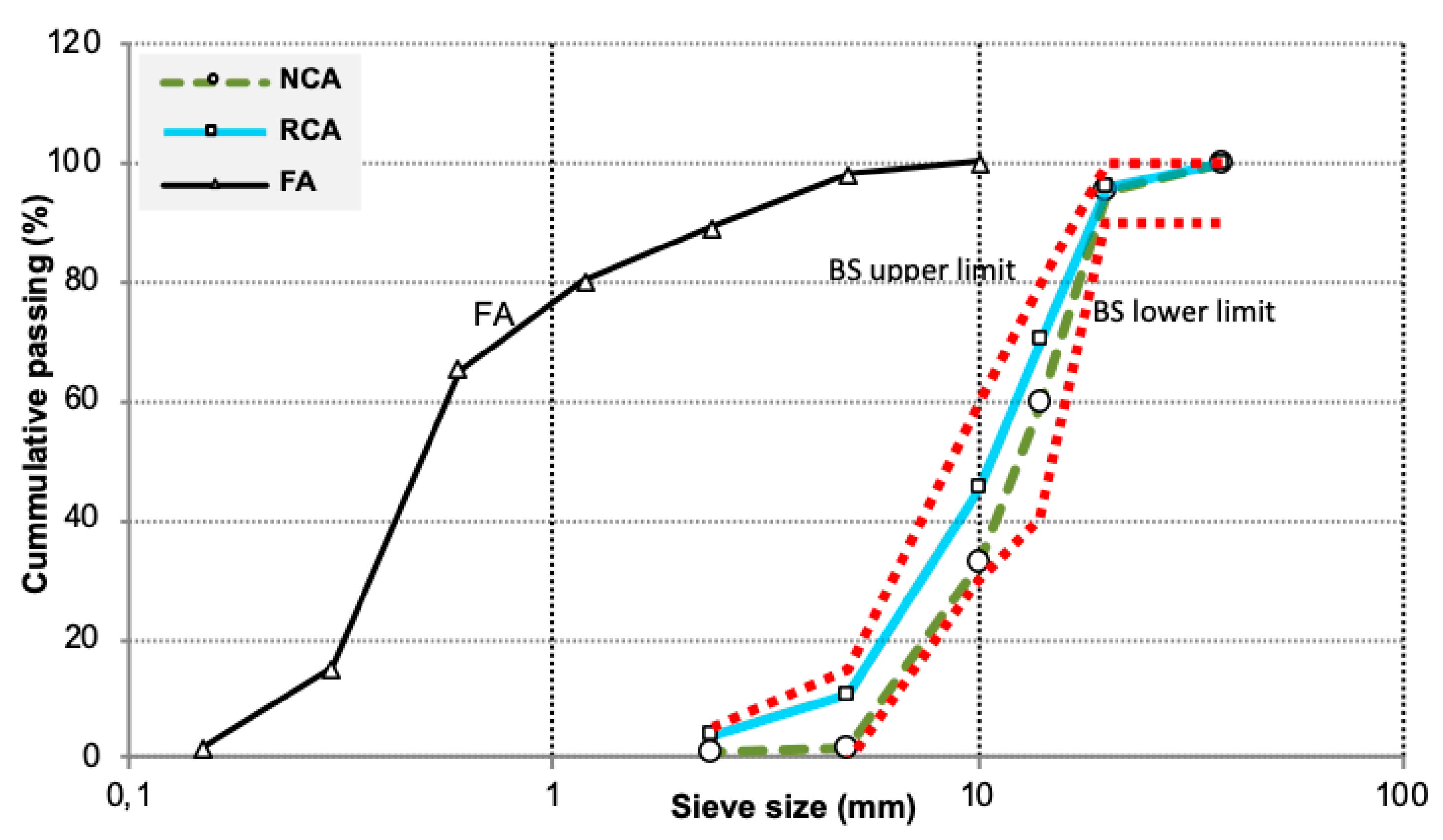
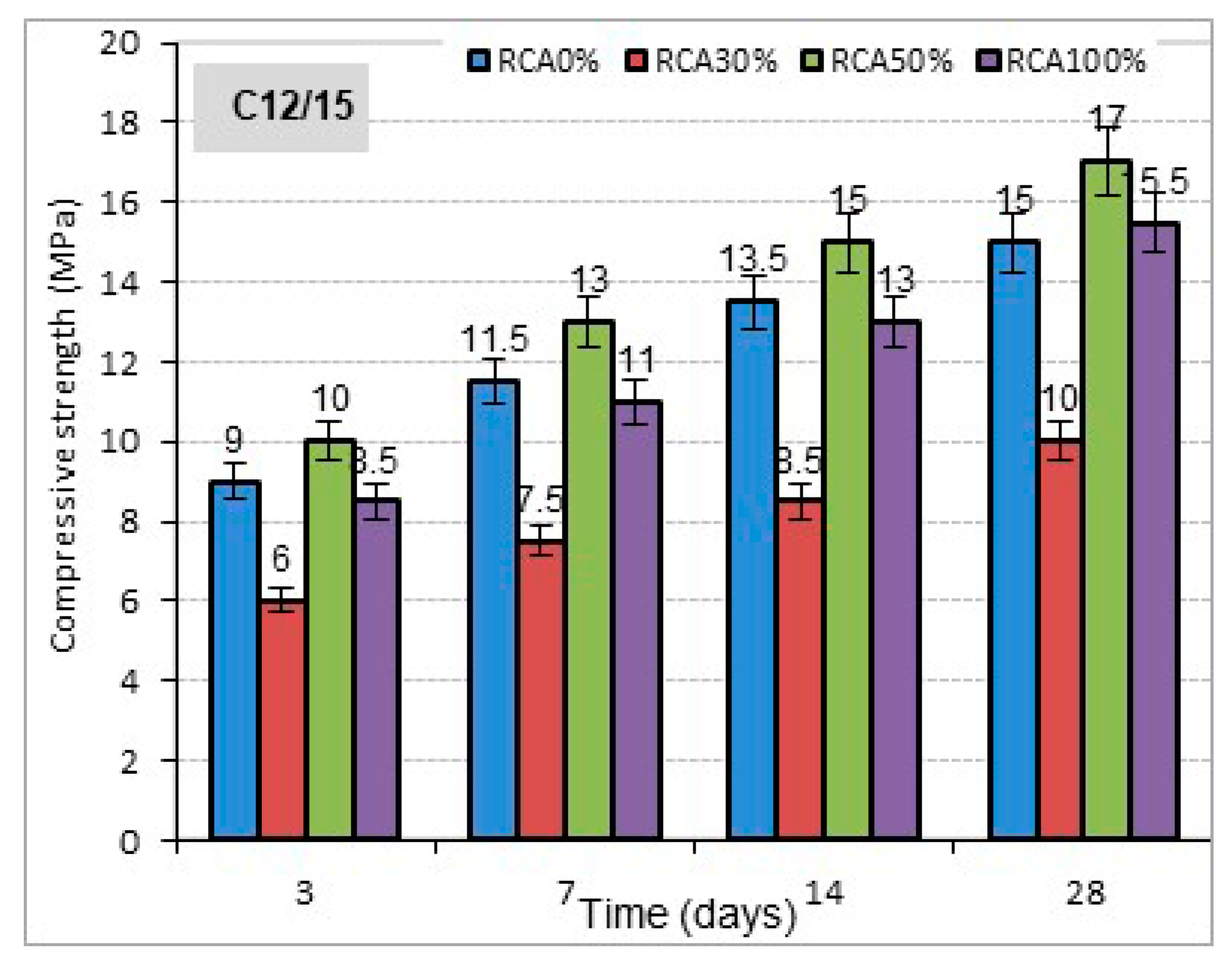
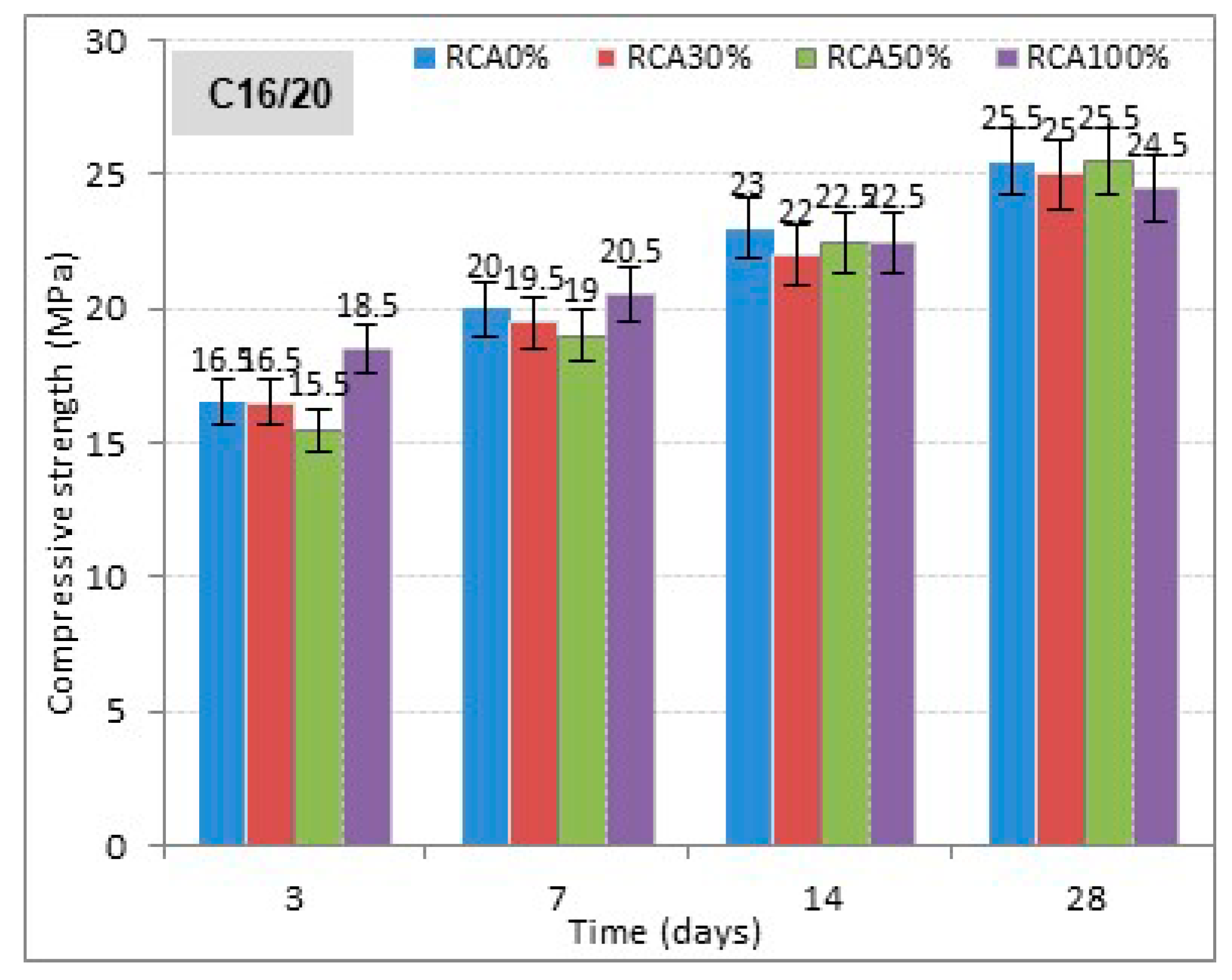
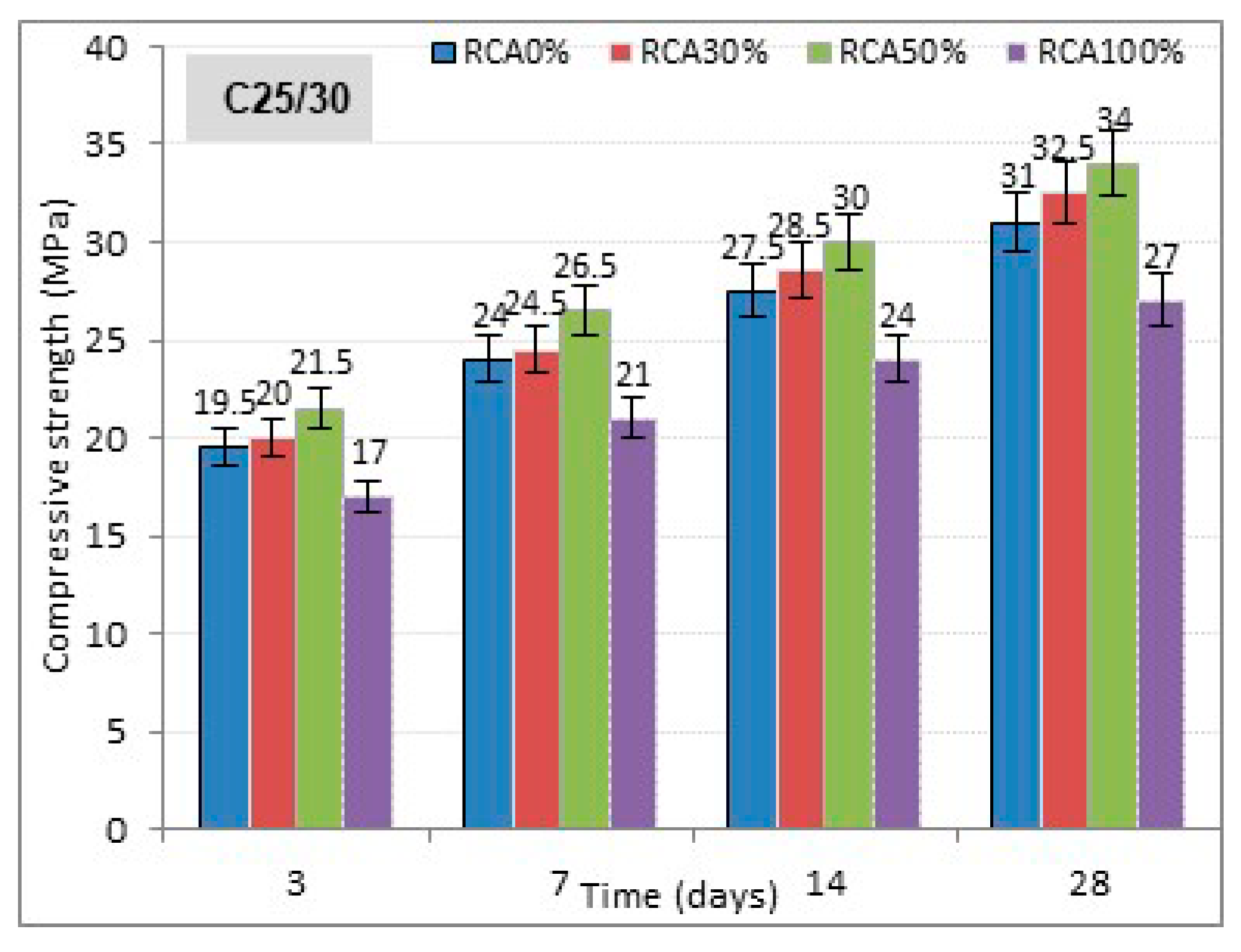


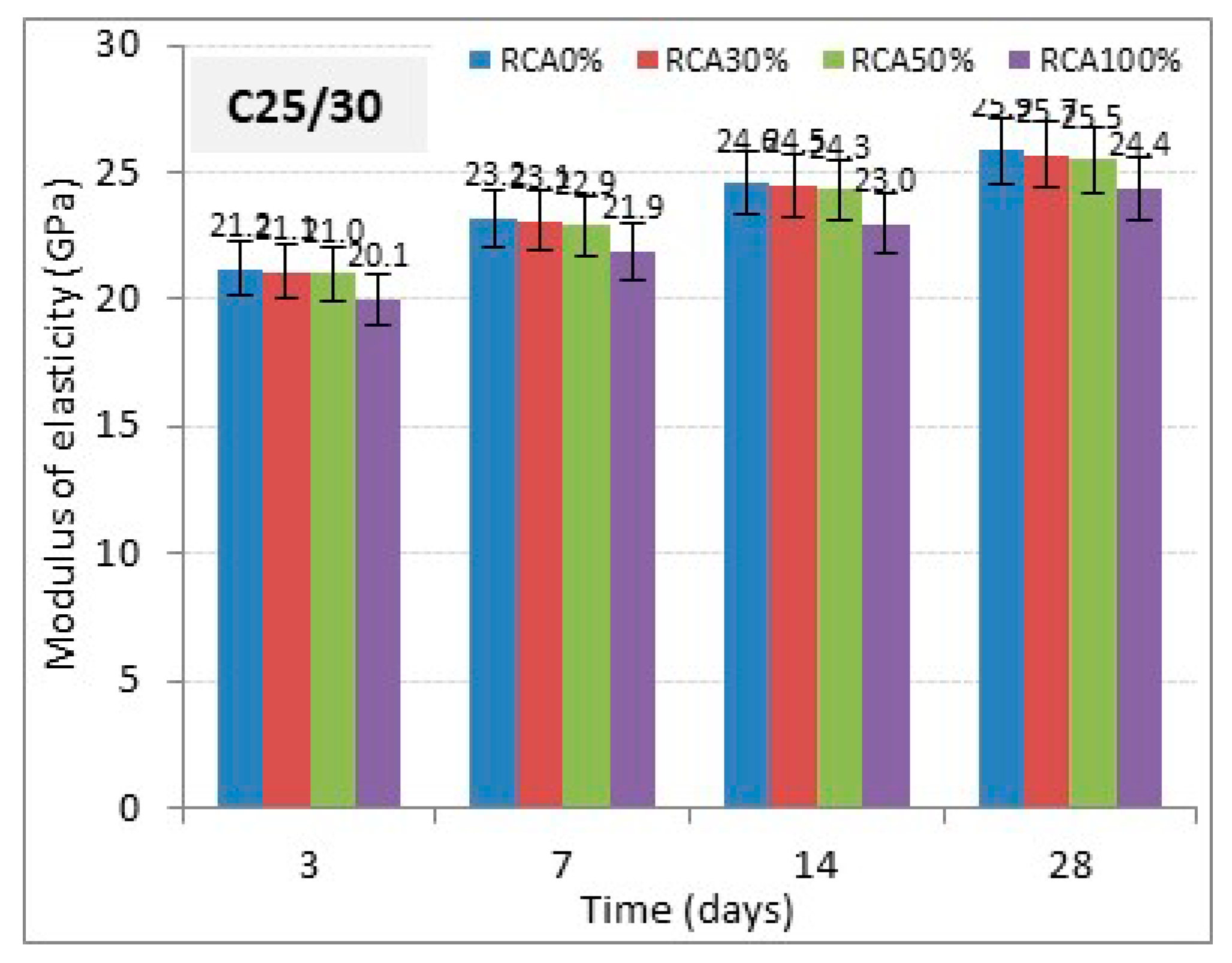


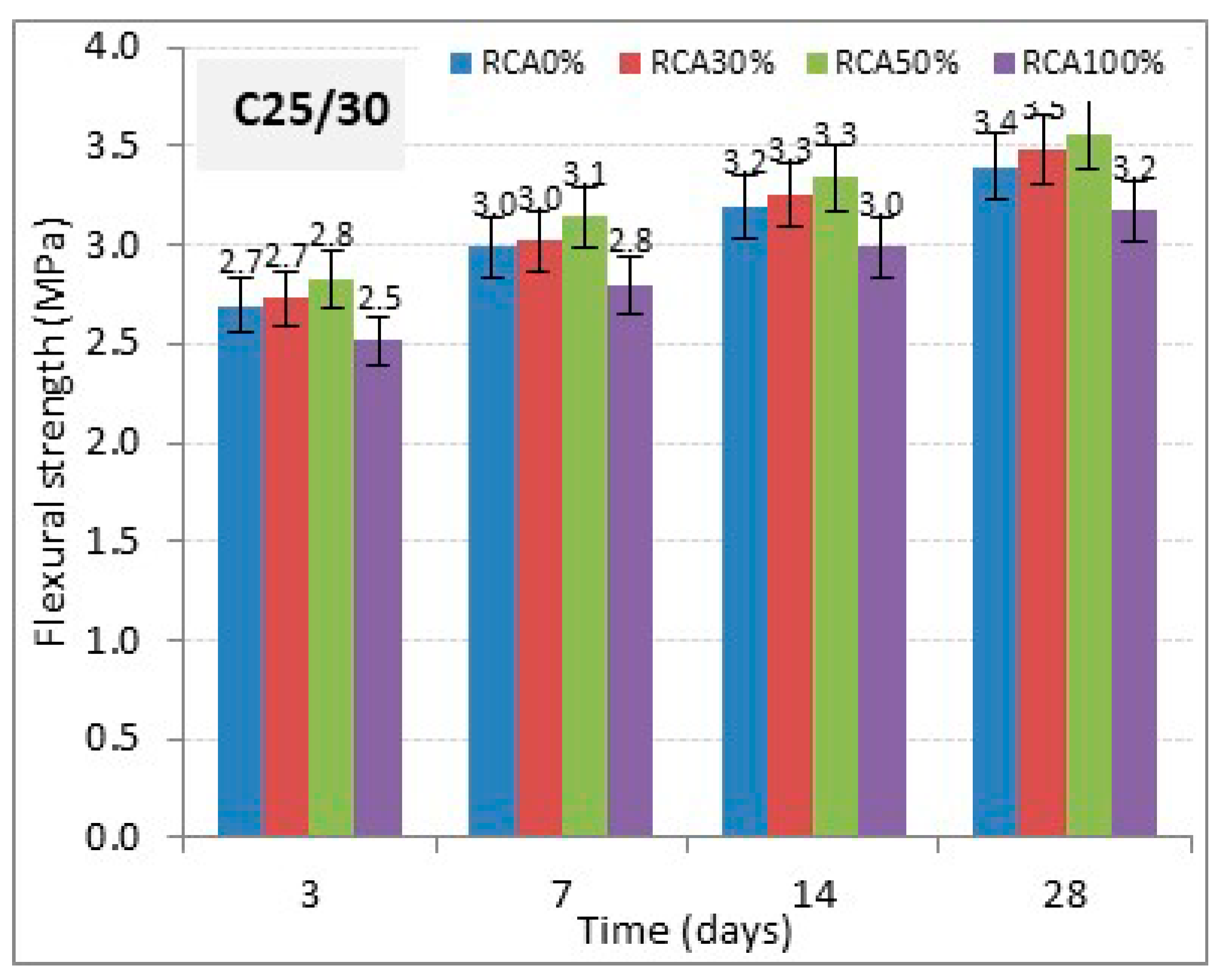
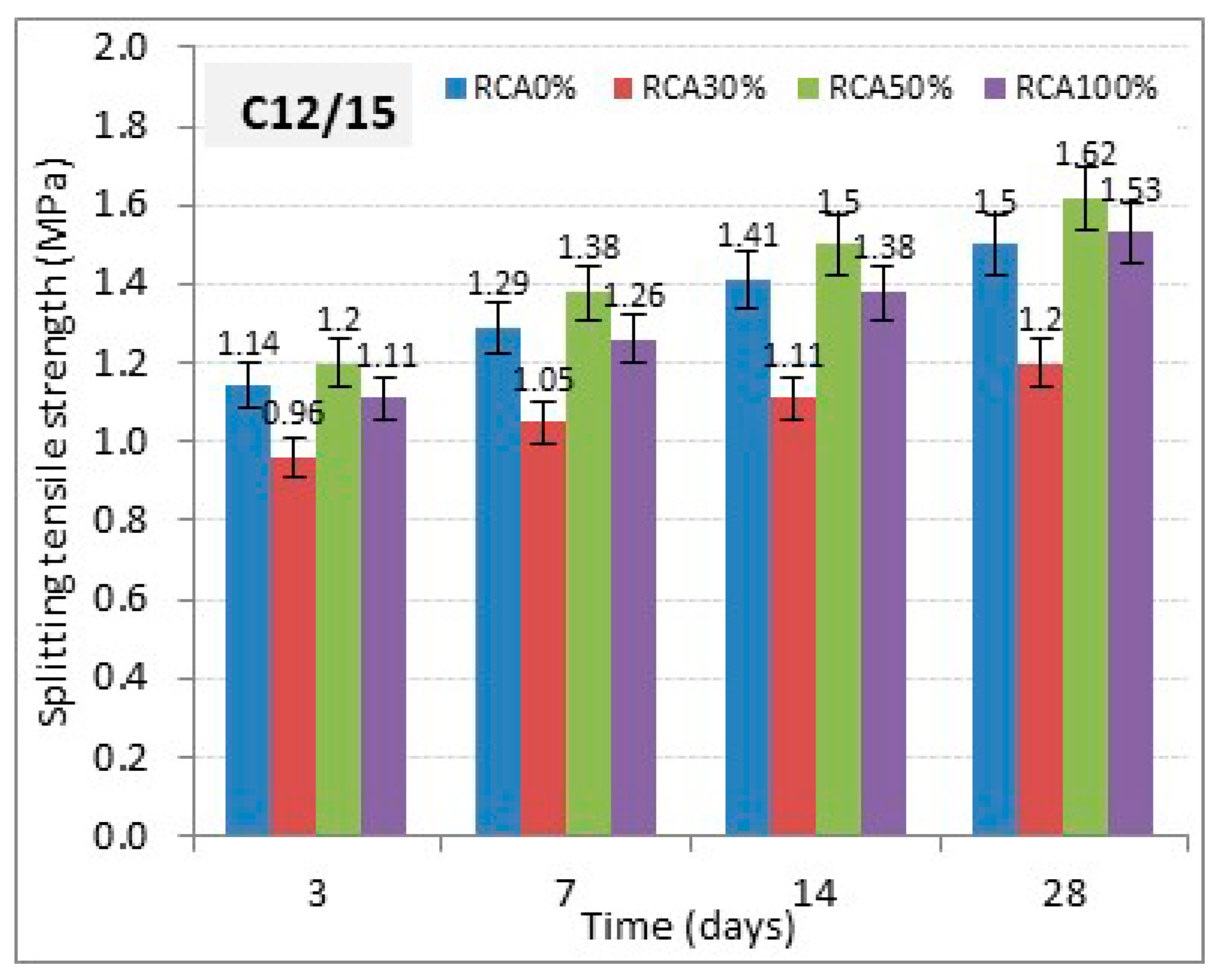
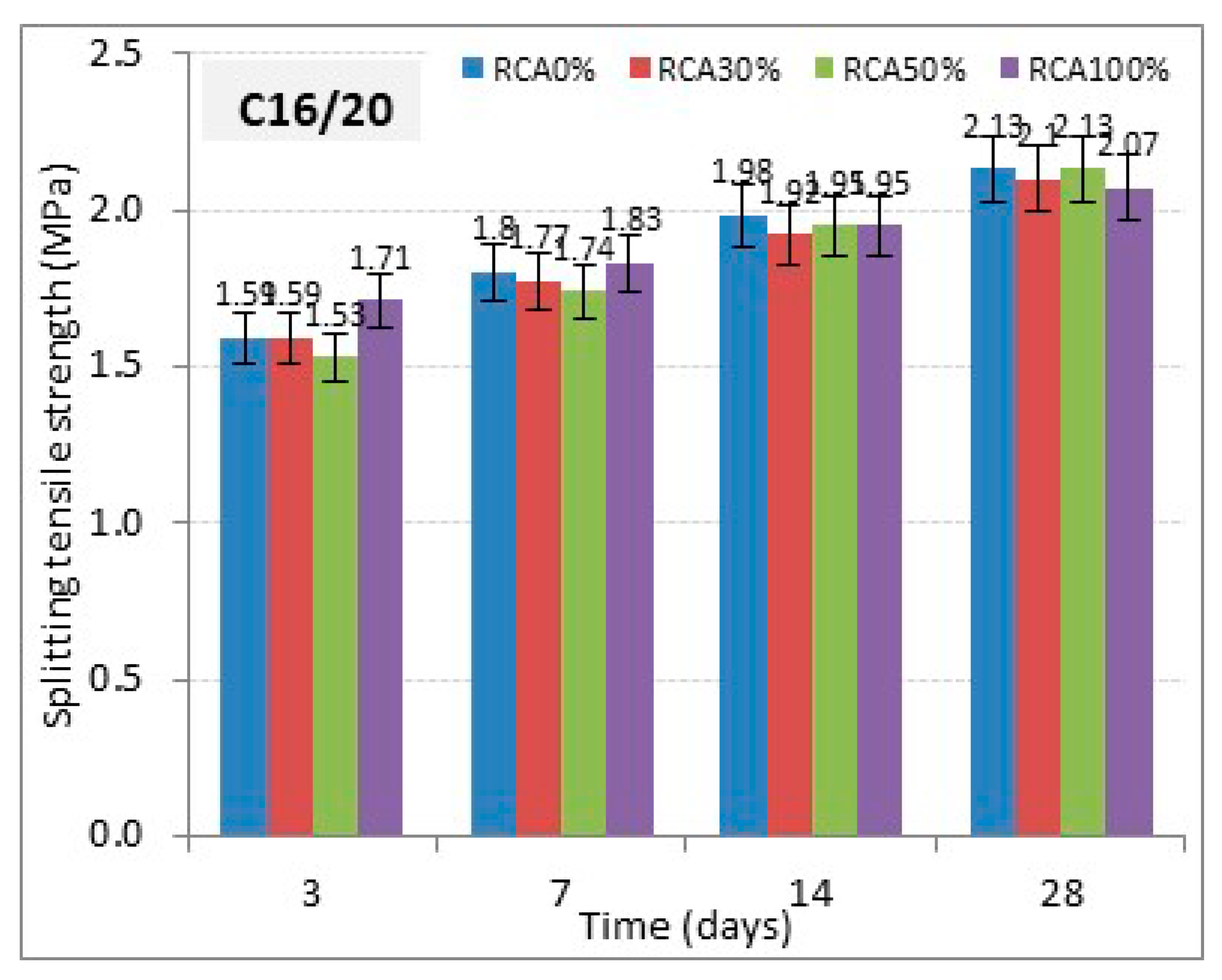


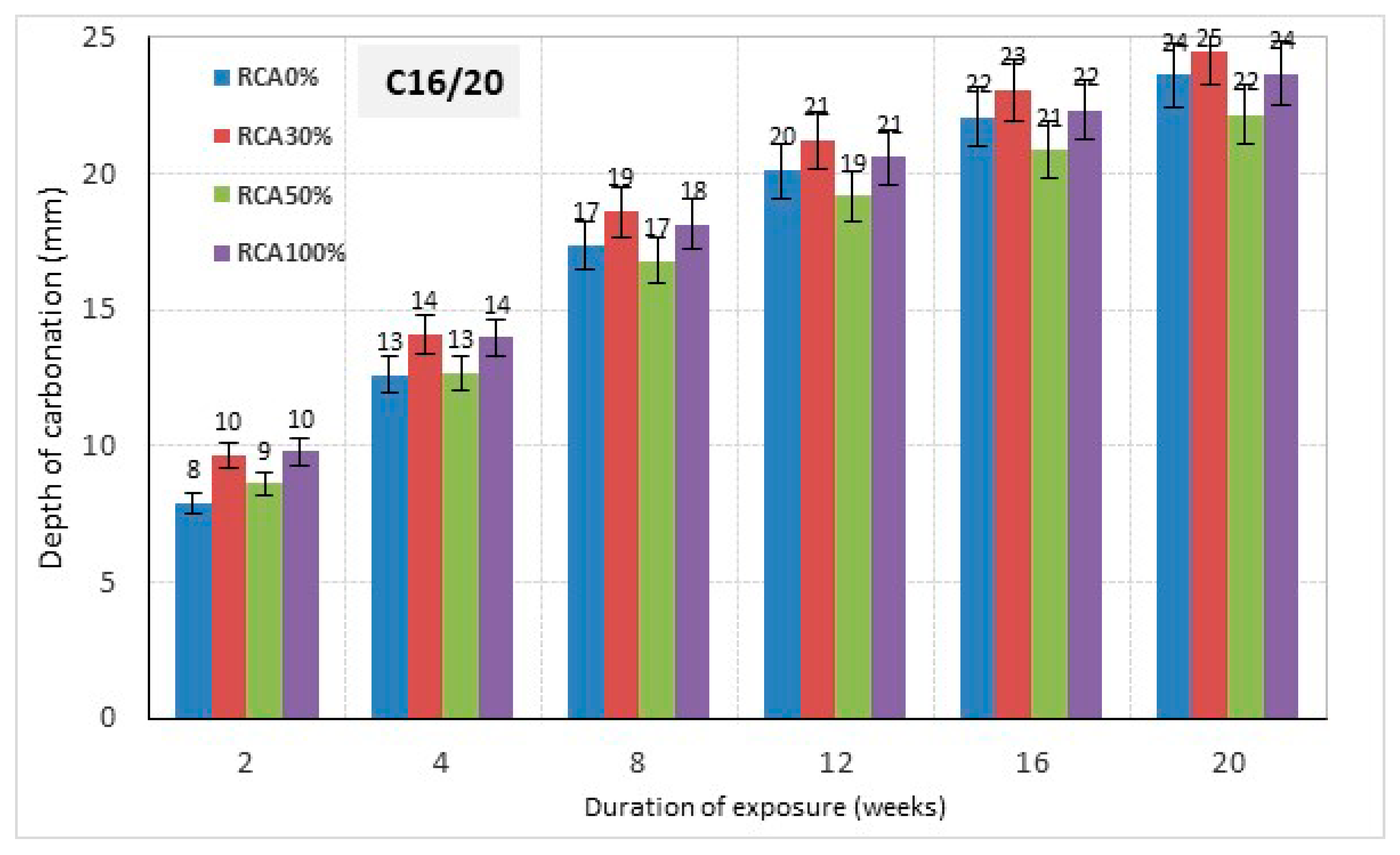

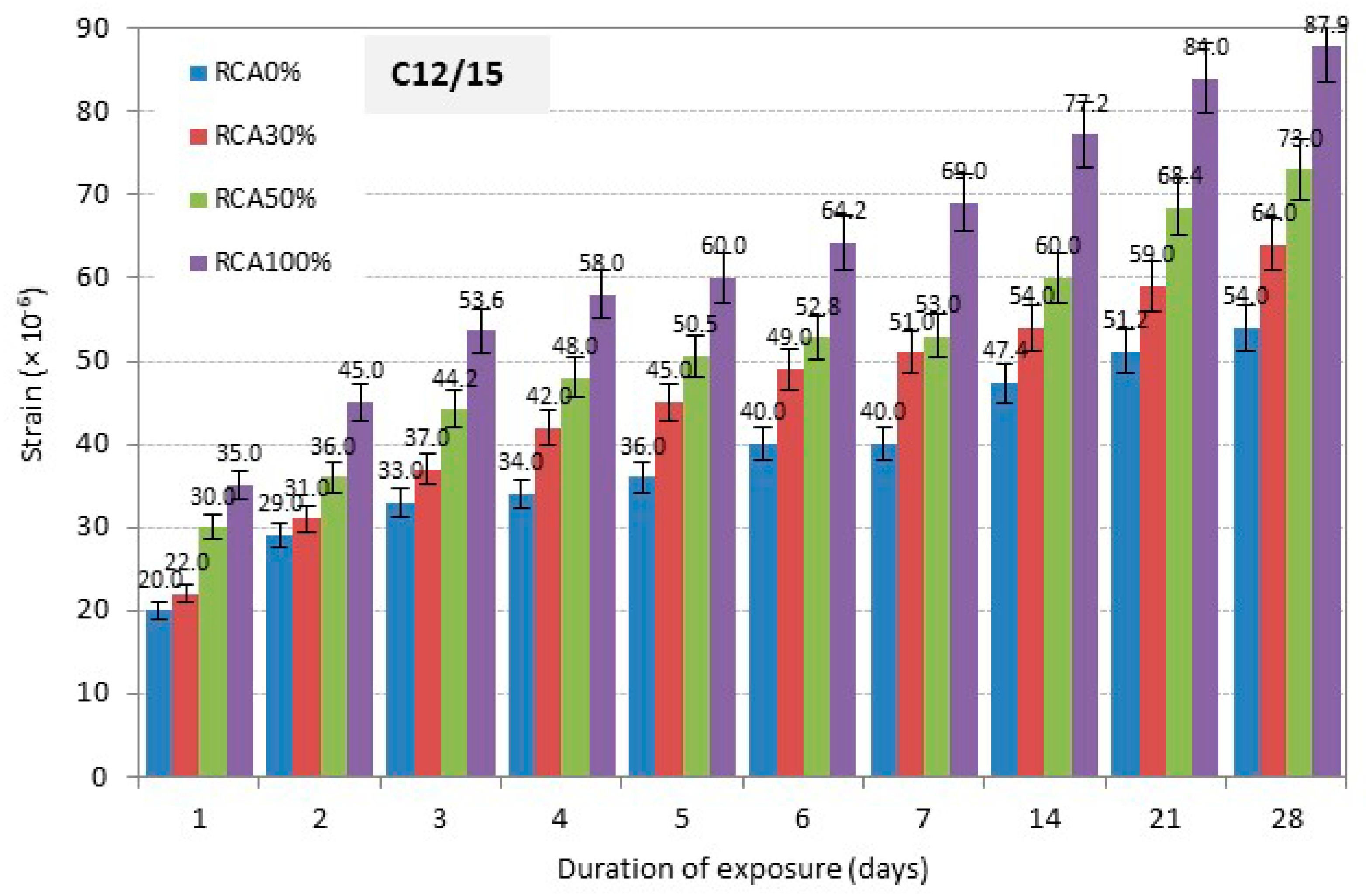
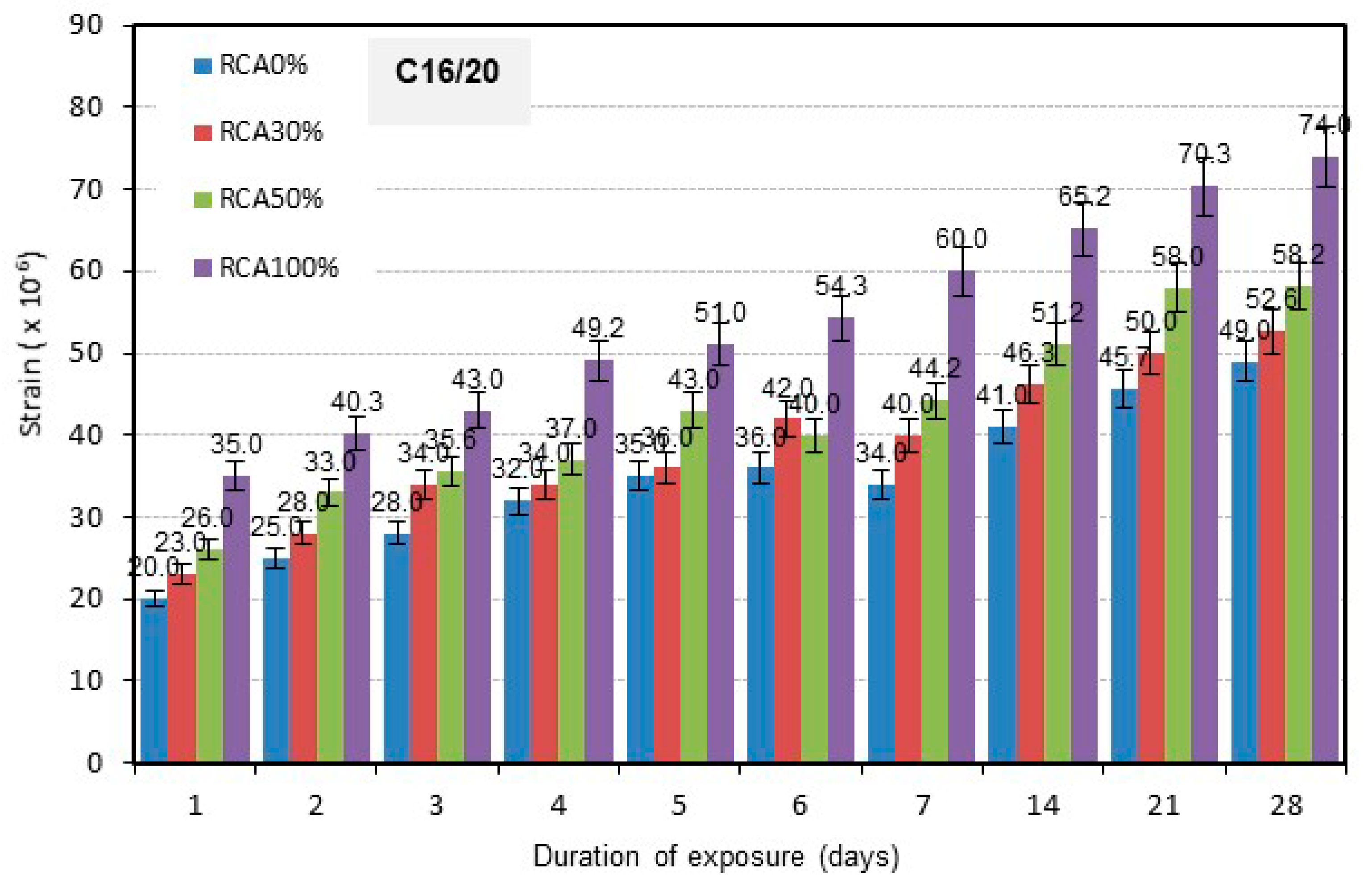

| Properties | Fine Aggregate (FA) | Natural Coarse Aggregate (NCA) | Coarse Recycled Concrete Aggregate (RCA) |
|---|---|---|---|
| Nominal size (mm) | 5 | 20 | 20 |
| Specific gravity | 2.68 | 2.54 | 2.43 |
| Dry-rodded Unit weight (kg/m3) | - | 1480 | 1280 |
| Water absorption (%) | 0.81 | 0.61 | 5.3 |
| Fineness modulus | 2.6 | 7.1 | 6.7 |
| Crush value | - | 12.4 | 23.4 |
| Mix Label | RCA (%) | Constituent (kg/m3) | |||||
|---|---|---|---|---|---|---|---|
| Cement | Water | Aggregates | w/c | ||||
| NCA | RCA | FA | |||||
| C12/15 | 0 | 185 | 180 | 1225 | 0 | 750 | 0.97 |
| 30 | 185 | 180 | 858 | 367 | 750 | 0.97 | |
| 50 | 200 | 180 | 618 | 618 | 725 | 0.90 | |
| 100 | 212 | 180 | 0 | 1247 | 701 | 0.85 | |
| C16/20 | 0 | 275 | 180 | 1260 | 0 | 625 | 0.66 |
| 30 | 275 | 180 | 882 | 378 | 625 | 0.66 | |
| 50 | 295 | 180 | 635 | 635 | 595 | 0.61 | |
| 100 | 310 | 180 | 0 | 1240 | 610 | 0.58 | |
| C25/30 | 0 | 330 | 180 | 1245 | 0 | 585 | 0.55 |
| 30 | 330 | 180 | 872 | 373 | 585 | 0.55 | |
| 50 | 355 | 180 | 623 | 623 | 560 | 0.51 | |
| 100 | 372 | 180 | 0 | 1252 | 536 | 0.48 | |
© 2020 by the authors. Licensee MDPI, Basel, Switzerland. This article is an open access article distributed under the terms and conditions of the Creative Commons Attribution (CC BY) license (http://creativecommons.org/licenses/by/4.0/).
Share and Cite
Meddah, M.S.; Al-Harthy, A.; A. Ismail, M. Recycled Concrete Aggregates and Their Influences on Performances of Low and Normal Strength Concretes. Buildings 2020, 10, 167. https://doi.org/10.3390/buildings10090167
Meddah MS, Al-Harthy A, A. Ismail M. Recycled Concrete Aggregates and Their Influences on Performances of Low and Normal Strength Concretes. Buildings. 2020; 10(9):167. https://doi.org/10.3390/buildings10090167
Chicago/Turabian StyleMeddah, Mohammed Seddik, Ali Al-Harthy, and Mohamed A. Ismail. 2020. "Recycled Concrete Aggregates and Their Influences on Performances of Low and Normal Strength Concretes" Buildings 10, no. 9: 167. https://doi.org/10.3390/buildings10090167
APA StyleMeddah, M. S., Al-Harthy, A., & A. Ismail, M. (2020). Recycled Concrete Aggregates and Their Influences on Performances of Low and Normal Strength Concretes. Buildings, 10(9), 167. https://doi.org/10.3390/buildings10090167





